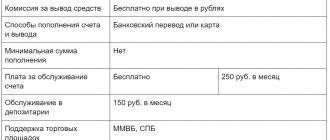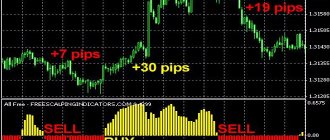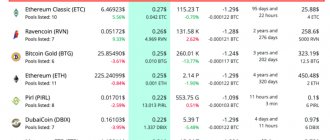Hello! In this article we will talk about such an investment tool as PAMM accounts. This is not a call to run and invest your hard-earned money, but a review of the tool.
Today you will learn:
- What are PAMM accounts;
- Is it worth investing in them?
- How to start investing in PAMM;
- And what kind of profit can you expect?
Content
- What are PAMM accounts
- Example of working with PAMM accounts
- Is investing in PAMM accounts profitable?
- Step-by-step instructions for making money on PAMM accounts
- Step 1. Choosing a broker
- Step 2: Making a deposit
- Step 3. Selecting a PAMM account
- Step 4. Watch and analyze
- Step 5. Take profit or minimize losses
- Choosing a broker for a PAMM account
- Rating of TOP 5 PAMM brokers
- PAMM accounts at Alpari
- PAMM in Insta Forex
- PAMM accounts in Forex Trend
- PAMM broker Alfa-Forex
- PAMM account broker Forex4You
- How to choose a PAMM account for investing
- Forums and collecting additional information about the trader
- Monitoring PAMM accounts
- All about the risks of investing in PAMM
- Tips for beginners
- Conclusion
What is the minimum amount needed to invest?
The good thing about a PAMM account is that you can get by with minimal funds. But:
- You will have to wait a long time for serious money (in principle, this is a very good method for “trying” investing).
- You need to find a company of investors to reach the minimum amount (each broker has its own requirements) and enter into an agreement with the broker company.
A company working with this type of investment has minimum deposit requirements. But the owners of a PAMM account can be several people. In this case, profits (as well as losses) are distributed in proportion to the investments of the participants.
What are PAMM accounts
In short: PAMM accounts to which investors transfer money so that they can trade on Forex at their expense.
This is a kind of analogue of investment funds - companies that trade on the stock market at the expense of their clients’ funds, and bring them profit. In Forex, the principle is the same, only the role of the management company is played by one person or a team that is engaged in independent trading, without forming a legal entity.
PAMM accounts (in scientific literature) are a financial instrument that allows you to use a trading account to transfer funds in trust to a trader for the purpose of making a profit.
Depending on the Forex broker, a different trading system using PAMM accounts is provided. In one case, this will be a simple transfer of funds to the managing trader, who will trade with them.
This method accumulates funds from one trader, relieving the investor of all operations. The disadvantages are obvious - the investor does not have any mechanisms to influence trading, except for one thing - he can withdraw his money.
But the second method deserves much more attention: scaling deals. The trader trades his small capital on his account (often 5-10 thousand dollars), and investors, wanting to invest funds in him, enter into an agreement with a system that carries out the same transactions on their accounts (with the same percentage of the main capital) that and main trader.
How to correctly create a PAMM portfolio
The first thing you need to do is decide on the share of PAMM accounts in your investment portfolio. It depends on your risk appetite. The calmer you are about possible losses in investments, the larger the share you can allocate:
- do not like risk: up to 10% of the portfolio;
- sometimes you take risks: up to 20% of the portfolio;
- like to take risks: up to 30% of the portfolio.
I would not recommend investing more than 30% of your portfolio in PAMM accounts because a good balanced portfolio should include stocks, bonds, precious metals and other traditional investments. Once you have calculated the approximate amount, you can begin to compile a PAMM portfolio . The minimum deposit is usually $50-100, take this into account when selecting your portfolio. It is desirable that it includes traders from all companies to protect against force majeure situations with brokers.
After the previous two sections of the article, you already have a ready-made database of 200 PAMM accounts in Excel and you already know how to choose managers yourself. For a portfolio, it is enough to select 5-10 best PAMM accounts, but it is advisable to study as many options as possible, because good strategies are not always popular among investors.
And lastly, how to distribute capital among managers. There are two options:
- an equal share for everyone - it’s still impossible to predict who will earn the most, so let them be on equal terms;
- the greater the drawdown, the smaller the share - we make the risks for each strategy approximately the same and are not afraid that one unsuccessful strategy will eat up all the profit.
I prefer the second option, so that the risks of each PAMM account are approximately the same - you never know whose trading strategy will stop working.
That’s basically all, all that remains is to keep track of the results of investments, draw conclusions and gain experience. I don’t often recommend changing the composition of a PAMM portfolio; everyone has bad periods; only time will judge who is still able to earn money and who is no longer able to earn money.
Example of working with PAMM accounts
You have 10,000 USD. You have found a good trader whose account yield is 150-200% per year. You enter into an agreement with the broker, according to which the same transactions take place on your account as the trader.
Example. You have 10,000 in your account, and he has 5,000. Having bought dollars with a leverage of 10 in the amount of 50,000 cu, and receiving a return of 2% on the transaction, he has a profit of about $1,000. An operation to purchase dollars in the amount of 10,000 USD took place on your trading account. with a leverage of 10, and in the end you received a profit of about $2,000 from the trading operation.
The advantage of this method of maintaining PAMM accounts is obvious - with current trading instruments you can increase or decrease risks when trading. You adjust the leverage that the trader uses, increasing it up to 5 times, or decreasing it by 2 times. This allows you to get less risk when working with aggressive accounts, and more profit when trading conservatively with a minimum of drawdowns.
Regardless of the trading method, there are three types of participants:
- traders – investors’ funds are accumulated in their accounts;
- investors - investors in traders;
- brokers are those who provide access to trading.
The interaction of the first two brings profit to the entire system - the broker receives new potential clients who think that trading Forex is quite simple, as well as an additional commission from all transactions.
It should be remembered that profit is the difference between the price of entering a transaction and its closing, minus the broker's commission.
Profit is distributed between the trader and investor depending on the agreement. Most large traders share profits with their investors in half, bringing them returns in the region of 50-60% per annum. More aggressive traders can receive up to 300-500% profitability, but also give investors about 200% per annum.
How do PAMMs work?
Let's say there is a certain trader (let's call him Vasya) trading on Forex. Its average monthly return is 10%. With his capital of $1,000, that’s only $100. Vasya is making progress in trading, constantly developing, learning effective trading techniques, and monitoring important economic news. In general, it shows stable results and profitability.
But one can hardly call 100 dollars a month an adequate payment for this work and the time (and nerves) spent.
Then Vasya decides to attract investors to increase working capital (and, accordingly, profits).
He opens a PAMM account.
Vasya was immediately able to attract 2 investors: Alexander and Zinaida. Alexander invested $10,000. Zinaida - 9,000.
The total amount of funds managed by Vasya is $20,000 .
Having again shown 10% profitability per month, the net profit was already $2,000 , which is distributed proportionally among all participants.
Eventually:
Vasya — +100$
Alexander — +1 000$
Zinaida — +900$
According to the terms (offer), Vasya’s remuneration is 50% of the profit received.
Eventually:
Vasya — +1050$
Alexander — + 500$
Zinaida — +450$
As you can see, everything is in profit and everyone is happy.
Vasya, for the same work (only by raising additional funds) increased his income by more than 10 times .
Investors do not need to trade on their own and waste time. The manager does all the work for them, which makes their income completely passive.
In fairness, it is worth noting that everyone is on an equal footing (both the manager and investors). All losses are also distributed evenly according to their contributions. And the manager too.
Therefore, the manager is extremely interested in obtaining stable profits.
Is investing in PAMM accounts profitable?
PAMM is a financial instrument, the use of which gives profitability 6-50 times higher than the average banking one. And it is also a passive method of earning money - almost nothing is required from a potential investor other than monitoring the trading account. It is precisely because of such profitability, coupled with a passive type of income, that PAMM accounts are one of the most profitable investments today.
PAMM accounts are a highly profitable and therefore extremely risky financial instrument.
Everything related to finance is directly dependent - the greater the risk, the greater the profitability. If a trader conducts his business aggressively, he may lose his entire trading account in one moment, but if he behaves passively, he will miss out on potential profits.
It is the balance between aggression and passivity that is the key to making money on Forex and PAMM accounts.
Example of profitability with PAMM investing for 6 months
$1000 into a PAMM account .
So, imagine that we divided our capital into 4 equal parts of 250 dollars and put them in accounts in different companies.
Let us determine that the average profitability will be from 7% to 10% monthly . From here we have:
- in January the profitability was 10%, since this month is considered the most profitable of the year, and therefore we earned $100;
- in February, profitability dropped to 5%, and we earned $50;
- in March we were able to get only 20 dollars, with a profitability of 2%;
- in April there was a drawdown and amounted to -8%, and we lost -$80;
- in May, participation in trust management brought a profit of 6% and amounted to $60;
- in June, profitability dropped to 4%, and we earned $40.
Thus, our profit was $190 in 6 months or 19% . Agree, it’s pretty good, this example is closer to real numbers .
Step-by-step instructions for making money on PAMM accounts
You can start making money on PAMM accounts in literally 5 steps:
Step 1. Choosing a broker
This is the most important step that you need to approach wisely. Many people underestimate the procedure for choosing a broker, believing that profits depend more on accounts, traders, and trading policies in general. But it is not so.
A fraudulent broker is the first obstacle to making a profit from a PAMM account. But even if a broker plays a fair game, he can indirectly reduce the investor’s or trader’s chances of success - not giving any trading signals, having poor optimization for trading, etc.
It depends on the choice of broker whether you will make a profit at all when investing in PAMM accounts. Some successful traders and investors insure themselves against unfair performance of their obligations on the part of brokers by dividing their assets into several companies. This allows you to minimize the risk of loss in the event of a scam (bankruptcy) of a legal entity.
Step 2: Making a deposit
After choosing a broker, there is a fairly simple technical procedure - replenishing your account. But before that, you need to study the trading terminal, “poke” different buttons - learn everything about the functionality.
This is done in order to avoid purely technical errors, which can result from inexperience and first acquaintance with the trading program. If you have any questions, it is best to ask them in tech. support. There are people there who are paid to answer customer questions.
Step 3. Selecting a PAMM account
This is also a rather important stage that needs to be approached by studying many materials, looking at reviews and blogs of successful investors. For beginners, the ideal option would be about a week of analyzing popular traders, and searching for reviews on independent forums, and after that forming a portfolio that will have enough investment.
If you don’t know which trader to invest your money in, you can also use the services of technical experts. support. Some Forex brokers advise novice investors to use more conservative players who are guaranteed to be able to make a profit.
Over time, you will be able to gain experience and choose suitable traders yourself based on the dynamics of their trading account and other independently found signals.
Step 4. Watch and analyze
After the money has been transferred to the trader’s trading account, you can begin the most important procedure - analyzing transactions. You don’t have to sit for days on end and watch when deals open and how. It is enough to come in once or twice a day, monitor drawdowns, avoid strong falls and keep an eye out for sharp rises.
By analyzing a trader's game, you can understand a lot - whether he will be profitable for you, or whether it is worth withdrawing your earned money. A good analysis will be able to provide information in advance about impending losses due to aggressive trading or indicate a loss of profit due to excessive passivity.
Nowadays, many terminals allow you to adjust risks by increasing or decreasing the leverage rate. This will allow you to optimize your partner’s trading strategy to the level that you, as an investor, need.
Step 5. Take profit or minimize losses
As with regular trading, the main task of the investor is to get maximum profit.
To do this, you can go in two ways: expansion and additional diversification of risks - making profit and distributing it among different brokers; invest additional funds in those already in your portfolio. Each method has its pros and cons, and which one to choose is up to you.
Now about something more important – minimizing risks. As soon as you see that the trader has “floated” - that is, he makes transactions emotionally, chaotically, or has lost his usual rhythm, then immediately take the money. Those who give in to emotions in Forex immediately go down the drain.
Also, if you see that the trader is regularly losing his account instead of making a profit, you need to withdraw your money as quickly as possible. A very rare number of traders make deliberate account drawdowns without taking profits at one of the obvious points, hoping to get more after a while.
If you trust your trader, it is better to talk to him and ask about his plans, because if you withdraw your funds, you will sharply provoke a decrease in the account, and, possibly, everything will snowball down on someone who just wanted to get a little more profit.
Tests
The main criterion for selecting accounts for tests will be the age of the account - projects that are two years old or more will take part in the test. The test itself will be carried out over the period of the last two years, as a sufficient period to assess the potential of the strategy.
As it turns out, there are actually few such accounts, because most do not even last a year of stable work. But in order to exclude adjustment of the results, accounts will be selected blindly, without regard to rating and profitability/loss ratio. These offers will not be taken into account in the calculation; we will assume that the services are provided free of charge. Also, for the test we will take daily balance data, which in practice will correspond to daily nightly rollovers.
The most “advanced” strategy for investing in PAMMs is considered to be entry on drawdowns. Here the imagination of investors is fully revealed, and everyone will probably tell you how to actually enter drawdowns correctly. We need a unified method, so in our case we will use the most primitive trading strategy from a trader’s point of view - entry in the direction of the MA. We take the usual 20-period MA and overlay it on the PAMM profitability chart. When the MA turns upward, we make a deposit; when it turns down, we withdraw funds. All this is well illustrated in the picture below.
The 20 day period is chosen as a natural monthly investment cycle and will be universal for all accounts. Also, for comparison, a stochastic strategy with parameters will be used: 20, 5, 5. In this case, the entry will be made at the intersection of the fast and slow stochastic lines.
The selection consists of 20 randomly selected PAMMs, which should be enough to test the idea. For each strategy, a deposit of $1000 is allocated. To speed up the process, testing was carried out by an automatic script. The return on investment was calculated using the following formula:
The graphs display the dynamics of investment returns in the case of a one-time deposit at the beginning of the period ( control balance in the screenshots), investing according to a strategy based on MA, and investing according to a strategy based on Stochastic.
- CoolMan - the manager has set himself a rather ambitious goal - 100% profit per month. The risks are a little overestimated, but the deposit load during the test did not exceed 30%. Success, however, is inconsistent, and rapid growth in profits is followed by an equally rapid decline. Based on publicly available information, one can judge from the fact that strict MM was not used - only the poor performance of the trading system is obvious. It is also worth noting that the manager had extensive trading experience, at least about 5 years.
- Control balance: $962
- Final balance on MA: $997
- Final balance on Stochastic: $1321
- COMOV is a medium-term strategy, according to the trader, with a systematic risk reduction. Practice shows the opposite; the loading of the deposit has constantly progressed over time. Again, according to the trader, the strategy was tested on a demo and real account. Unfortunately, the trader did not even have the understanding that cross rates are easily calculated from majors. In this regard, there are constant drawdowns and averaging. The report included the recovery period after the drain of most of the investor funds.
- Control balance: $166
- Final balance on MA: $869
- Final balance on Stochastic: $310
- -DAEMON- – trading hasn’t even really started. Since the date of publication of the invoice, there has been horizontal chatter with varying degrees of success. Not a word about the very principle of the strategy. But that’s why this approach was chosen - you never know what’s really on a trader’s mind. Even if you approach the selection of a PAMM project with the utmost caution, it is still possible that your account will be suddenly drained.
- Control balance: $101
- Final balance on MA: $469
- Final balance on Stochastic: $266
- CSForex – a mix of different strategies was used on this account, judge for yourself how successful it is. The account doubled in the first year after its creation, but this period was not included in the test. Ideally, the strategy should cut off all unprofitable periods in this case. This is partly what happens, but the result is highly dependent on the moving average period.
- Control balance: $537
- Final balance on MA: $750
- Final balance on Stochastic: $689
- Anzhelika – manual trading on major currency pairs. Very strict money management, but using martingale. The last drawdown is precisely due to overstaying and triggered stop loss. The strategy allowed us to cut off one large drawdown and slightly stabilized the profitability chart.
- Control balance: $1950
- Final balance on MA: $1908
- Final balance on Stochastic: $1516
- Abeiks – this example shows where the strategy works poorly. The manager sits out losses, changes vehicles like gloves and there is no stability at all in the account. For technical analysis to work, stable trading and a smooth return schedule are required, otherwise a lot of profit will be lost due to MA lags.
- Control balance: $4626
- Final balance on MA: $1864
- Final balance on Stochastic: $4331
- Ahh - clear signs of an aggressive martingale - the drawdown in the middle is proof of this. The strategy does not handle such situations well, since the rollover in our case occurs once a day, and the loss on the martingale grows very quickly, in most cases, most of the deposit is lost in a day. So it turns out that by the time the drawdown is detected, it is too late to exit, and instead of cutting losses, we cut profits.
- Control balance: $1384
- Final balance on MA: $1276
- Final balance on Stochastic: $1262
- Cuxirezo – GBPUSD is traded on the hourly timeframe, but the trend is determined by the weekly chart. The risks are average, about 15% of the deposit. To determine the entry, primitive technical analysis is used. There are few trades, all with stops (this can be seen from the chart). According to the manager, the payback period should not exceed six months. Interestingly, he also recommends using a portfolio strategy. In this case, fairly stable trading with clearly defined stops played into our hands. If there are patterns in the input data, technical analysis works well.
- Control balance: $1033
- Final balance on MA: $1119
- Final balance on Stochastic: $959
- CoolFlame - in fact, there was no profit on this account - PAMM almost immediately went into the red. The risk for each order is 5%. But, naturally, when it comes to sitting out, the risk is many times greater, and the leverage of 1:500 is used to its fullest. There is no clearly developed strategy, so investing on drawdowns does not give any impressive results.
- Control balance: $3657
- Final balance on MA: $1643
- Final balance on Stochastic: $5150
- AlexStarkov is an example of where an investment strategy really works. A strictly defined risk (for all two years the load did not exceed 10% of the deposit) and the precise operation of the automatic trading system allows you to reduce losses to a minimum. The instrument used is EURUSD, an hourly chart, which also to some extent contributes to the stabilization of trading results. In such a simple way, using one trading system you can easily increase the profits of another.
- Control balance: $800
- Final balance on MA: $932
- Final balance on Stochastic: $854
- Ametisto – the strategy worked well for the second part of the trading period. Risks have decreased and trade has stabilized and, at the same time, the results of the PAMM project have become more predictable. The flat periods on the right chart correspond to periods of withdrawal of investments from the account when the moving average of returns turns downward. When an account has periodic ups and downs and moderate volatility, this approach avoids unprofitable periods.
- Control balance: $1598
- Final balance on MA: $1670
- Final balance on Stochastic: $1073
- _LowRisk_ – and now let’s look at one of the worst-case scenarios. Nobody wants to deal with homogenizers and, I think, it’s clear why. Here, the manager’s little experience, a standard averaging robot and high leverage create an explosive mixture, leading to crazy volatility in the account and the inapplicability of technical analysis. The trader himself recommends entering at a drawdown, which again indicates his preparedness. If you already invest in such a strategy, then without unnecessary movements - with one investment. Otherwise, we will constantly be late in making investments in the hope of seeing a profit that never happened.
- Control balance: $889
- Final balance on MA: $538
- Final balance on Stochastic: $638
- 2014-01-05Su is not the best account for the investment strategy, since approximately in the middle of the period there was a change in the vehicle. Initially, a conservative trade was planned, which was later replaced by a much more aggressive strategy. Despite such metamorphoses, the MA investment strategy helped avoid several large drawdowns, with virtually no impact on profitability. We may not have won anything here, but the risks have been significantly reduced.
- Control balance: $1931
- Final balance on MA: $1724
- Final balance on Stochastic: $2177
- FSC – the chosen strategy insures us against complete loss, the possibility of which always exists. When the trader neither loses nor earns money, the following situation arises - as soon as we decide to deposit money, the manager again enters a drawdown.
- Control balance: $2328
- Final balance on MA: $1533
- Final balance on Stochastic: $2264
- Conservative trade 1 – this account belongs to one very active trader. Its developments are characterized by great complexity and low efficiency. The extremely unstable risk policy is not at all in our favor - at the beginning of the period we were dealing with a conservative strategy, after which the volatility of returns increased by an order of magnitude. And although the strategy did not bring profit, it still allowed us to avoid the biggest drawdowns.
- Control balance: $1024
- Final balance on MA: $956
- Final balance on Stochastic: $819
- 325 - when it comes to openly unprofitable projects, the investment strategy shows maximum efficiency. We still lose money on corrections and false rallies, but it doesn't compare to the losses we would have had if we had simply deposited at the beginning of the period and withdrawn at the end.
- Control balance: $392
- Final balance on MA: $973
- Final balance on Stochastic: $453
- 311177 – a small number of transactions and manual trading on a high timeframe. The trading result is unstable and the moving average in this case is clearly not entirely suitable. The final losses are not as large as the drawdown.
- Control balance: $930
- Final balance on MA: $820
- Final balance on Stochastic: $869
- Amelia – here we also see one of the worst scenarios, as in option number 12. Extremely unstable trading on the account and the lack of a clear trading system have a bad effect on the predictability of profitability. As a result, risks did not decrease, and profits fell.
- Control balance: $1799
- Final balance on MA: $1268
- Final balance on Stochastic: $1337
- Abailard – there is no gain in profit, but we have reduced the risks – the relative drawdown has decreased significantly. Trading throughout the entire period was quite stable, maintaining the MM level set at the beginning.
- Control balance: $1036
- Final balance on MA: $959
- Final balance on Stochastic: $824
- ALEXX – the investment strategy is clearly the winner in this pair. Despite the low profit, the strategy allowed us to avoid a simply gigantic drawdown. As a result, we got an almost flat chart, instead of a big loss in the middle of the trading period. We would not have received such an advantage if the drawdown had occurred within one day (let me remind you that the strategy’s reaction time is equal to one trading day).
- Control balance: $1443
- Final balance on MA: $1068
- Final balance on Stochastic: $1233
Choosing a broker for a PAMM account
Now let's take a closer look at choosing a broker. But before listing the best brokers, you need to understand one thing. Most investors look at the conditions that the company provides to them. That is, brokers, wanting to attract money, increase the opportunities of investors, sometimes not even in favor of traders.
Such companies should be avoided, because they do not have good players who can bring excellent profits. Such sites attract mediocre people who receive an average income with an average investment.
Rating of TOP 5 PAMM brokers
Below we present 5 brokers that are most often requested on the Internet.
There are many more platforms, but these are the best, according to reviews and opinions of participants, in order to start investing in PAMM. With experience, you will be able to use less popular and reliable companies in order to maximize profits and avoid scams in time. But at the initial stage of investment, these will be the simplest, most reliable and stable brokers with the most interesting traders.
Each broker has its own rating of PAMM accounts, and below we will talk in more detail about how to choose the best ones.
PAMM accounts at Alpari
The largest and oldest forex platform in Russia and the CIS. It has existed since 1998, and is not going to give up its leading position. Does this mean they are the best? No. This site is characterized by what we talked about above - the best conditions are created for investors, but not for traders. Therefore, there are very few high-quality managers in Alpari, and the entry threshold for them starts from $1,000.
An analogy can be drawn with the banking sector and Sberbanks in particular. The most reliable bank? Undoubtedly. What's the easiest way to open a deposit? Without a doubt. Good interest rates? No. Same with Alpari. Reliability and simplicity come before profitability.
The site is ideal for beginners - you can be guaranteed to gain experience and not lose your account. Alpari PAMM accounts are the best option for those who do not want to take risks.
PAMM in Insta Forex
Quite an interesting site, which is characterized by a huge number of training manuals. This is where many top Asian traders started, and this is what is good for both a trader and an investor to start on the CIS market.
But for beginners, it will probably be in second place after Alpari, simply because the first exchange is more reliable, older and simpler.
The site is ideal for those who love statistics and know how to use large amounts of data. Here you will find everything: from the number and currency of transactions, to the expected maximum drawdown. This amount of data allows already sophisticated investors to analyze trader accounts down to the smallest detail. If you have experience and analytical thirst, this is the place for you.
PAMM accounts in Forex Trend
A platform ideally suited for PAMM investing. It was she who introduced a new approach with transferring transactions to the investor’s trading account. Their main feature is that they are the first in the development and application of new technologies. Working with this broker, you get a variety of trading and analytical tools, the number of which is updated almost every week.
PAMM broker Alfa-Forex
A platform that focuses specifically on investors. Managers receive a commission only if they win back their trades.
The main feature is complete transparency. You see in real time where your money is going and you can stop it in time.
PAMM account broker Forex4You
A platform that is ideal for investors who want to create completely passive income. The broker allows you to automatically record and withdraw profits, and unique trading tools make it attractive for traders. In general, this is the European style - stability, reliability, honesty.
My rating of PAMM accounts from all brokers
As you already know, more than 2000 PAMM managers simultaneously offer their services to investors. It takes too long to analyze each individually, and official ratings of brokers make the same mistake - they use profitability for ranking without taking into account the riskiness of trading. Because of this, interesting PAMM accounts of professional traders are lost in the shadow of aggressive martingale traders.
To find all the interesting managers from different brokers, I use my own rating of PAMM accounts. It includes 200 traders, the information collected on them is saved in an Excel file, which I share with you at the link below:
Principles for compiling the rating. Depending on the use of toxic trading techniques (martingale, averaging, grids, etc.), all PAMM accounts are divided into three categories - A (low risk), B (medium risk) and C (high risk). This allows you to compare strategies with similar risk levels and find the most profitable among them. Each PAMM account is awarded points for annual returns, with the greatest weight given to results over the last two to three years.
Whoever earns money now is among the leaders - this is the main idea of the rating.
Managers who have stopped making money are rapidly losing positions and past achievements will not help them - this allows them to avoid outdated strategies.
PAMM account rating “A” - low risk
Reliable PAMM accounts suitable for long-term investing fall into this category. They are not in danger of a complete loss due to the complete absence of toxic trading methods and the low leverage used. You shouldn’t expect exorbitant returns, but the best managers from the A rating close almost every year in the black.
Conditions for getting into the “A” rating:
- The operating time of the current trading strategy is more than 3 years;
- there are no martingale elements in trading;
- maximum drawdown below 50%.
The best PAMM accounts with “A” rating (deposit – $100):
| # | PAMM account | Points | Min. deposit | Commission | Broker |
| 1 | Vesperium | 26 | 50 USD | 35% of profits | Alpari |
| 2 | Hohla | 26 | 50 USD | 20-40% of profit | Alpari |
| 3 | American Dream 1 | 24 | 50 USD | 29% of profits | Alpari |
| 3 | Itera | 15 | 50 USD | 15-30% of profit | Alpari |
| 4 | DesertSky | 12 | 10 USD | 19-20% of profit | ICE-FX |
PAMM account rating “B” - average risk
PAMM accounts with high risk fall into this category; sooner or later they will lose more than 50% of investors' funds and can even be merged (but not in a couple of days). Some B rated managers use high leverage, some use toxic trading techniques, but with restrictions. In general, these PAMM accounts are suitable for investors who want to earn more than 10% per annum and are not afraid to take on additional risks.
Conditions for getting into the “B” rating:
- The operating time of the current trading strategy is more than 2 years;
- there are no martingale elements in trading;
- the maximum drawdown is not limited.
The best PAMM accounts rated “B” (deposit - $100) :
| # | PAMM account | Points | Min. deposit | Commission | Broker |
| 1 | IPFx2 | 84 | 1 USD | 0% of profit | FxOpen |
| 2 | LowRiskTrading | 76 | 50 USD | 20-40% of profit | Alpari |
| 3 | Hohla Aggressive | 44 | 3000 RUB | 20-30% of profit | Alpari |
| 4 | Moriarti | 43 | 50 USD | 20-40% of profit | Alpari |
| 5 | Avtomatika | 39 | 50 USD | 26-48% of profit | Alpari |
PAMM account rating “C” – high risk
This category includes those PAMM accounts that do not meet the “A” and “B” rating criteria. They have the highest risk and almost all of them actively use martingale, so they can be drained quickly at any time. Such PAMM accounts appear in dozens every month, so in order not to add more work to myself, I set a limit on getting into the rating - at least 1 year of age. ~20% of PAMM accounts survive to this date, so in essence, the “C” rating is a survivor’s mistake. Such accounts may be of interest to you as a chance to quickly earn more than 100% profit - to recoup your investments and earn as much as you can on top. It's better to invest money in Bitcoin than to try to play this roulette.
Conditions for getting into the “C” rating:
- lifetime minimum 1 year
The best PAMM accounts rated “C” (deposit – $100):
| # | PAMM account | Points | Min. deposit | Commission | Broker |
| 1 | Eco 95M | 141 | 50 USD | 15-50% of profit | Alpari |
| 2 | SELLBUY01 | 141 | 3000 RUB | 20-45% of profit | Alpari |
| 3 | Chance Invest | 122 | 50 USD | 50% of profits | Alpari |
| 4 | Subang City | 119 | 100 USD | 20% of profits | FxOpen |
| 5 | AAA Class | 117 | 3000 RUB | 33% of profits | Alpari |
In general, you can invest in a PAMM account from category “C” without even knowing it. And the loss of 100% of the deposit, which always ends with such investments, can be an unpleasant surprise. Therefore, it is very important to recognize a “draining” PAMM account in time and ask yourself: is it worth taking more risks for the opportunity to earn more?
How to choose a PAMM account for investing
Now to an even more difficult task - finding a manager. All the information you need can be found in the broker’s trading terminal and on special forums.
The first thing we look at is the dynamics of the trading account. If it gradually goes up, then this trader is trading profitably and cautiously. Its profitability will be about 100% per annum, the possibility of completely draining the deposit is minimal. You can call this conservative trading.
There are aggressive accounts. They are characterized by the use of large leverage and, as a result, large drawdowns and equally large winnings. The profitability on some aggressive accounts goes beyond 300% per annum, but the risks are considerable.
Due to their attractive profitability, most investors prefer to have 2-3 aggressive accounts in their portfolio, or even create a separate “aggressive” portfolio with high profitability, which contains traders who, with their high profits, interrupt each other’s drawdowns.
A balance between conservative and aggressive traders must be maintained. Advantage should be given to conservatives, because they are almost guaranteed to bring in income without losing money.
There is also another category of traders whose accounts SHOULD NOT be in your investment portfolio. We are talking about martingale and those using its strategy in trading.
For those who don't know, the Martingale theory is based on doubling your bets after losing. This theory is dangerous because during a long streak of failures, it brings the trading account to 0 extremely quickly. And with a long series of victories, we do not see a significant increase. That is, at one point, every martingale operator will come to the point where his trading account will be equal to 0, regardless of his trading style. This is why such traders should be avoided.
It is quite easy to distinguish them if you have some experience. Martingale is characterized by gradual gains over a distance, one-time large drawdowns, and one-time quick profits.
Conclusion: the best PAMM accounts are those that bring profit to their investors.
Conclusion
Not in all cases, investment strategies have shown unambiguous effectiveness. In some places we see an increase in profitability, however, in some cases we even see an increase in losses. However, in most cases, technical analysis helped reduce losses and also showed a better profit-to-drawdown ratio.
The problems of analyzing a PAMM profitability chart are almost the same as when analyzing conventional price charts - poor predictability of results. Inexperienced traders often change risks, strategies and heavily load the deposit. In most cases, this leads to at least unstable profitability, and at most to a complete loss. It is important to understand that with poor predictability of profitability, no strategy will show good results. In fact, such investing will not be fundamentally different from trading any currency pair.
Still, advanced strategies have great potential, as can be seen in some of the accounts we tested. At a minimum, even the most primitive strategy can protect you from large losses. Apply strategies wisely, carefully select PAMM accounts for your portfolio, and you can to some extent protect yourself from unexpected losses, and perhaps even increase the profitability of your investments. Also, keep an eye on our monthly Investor Digest.
Forums and collecting additional information about the trader
In addition to the trading account, special PAMM forums must be used to collect data. On them you can find a lot of interesting information about certain traders.
For example, in 2014, on Alpari the second largest trader in terms of capital showed a return of around 200-250% per annum over the past 2 years. His trading account experienced only a few drawdowns, while investors' profits steadily climbed upward.
But the old-timers of the forum remembered that the same trader drained his accounts about 5 times in order to achieve such amazing dynamics. This was done in order to attract a large number of investments and maximize profits in a short time. And they warned most newbies that this trader could also drain his account.
Of course, it didn’t come to this, but thanks to one large-scale drawdown, about 30% of the funds were withdrawn from his assets, significantly shaking his profitability, and soon reducing the entire trade balance to almost 0.
Looking for such information is the task of someone who wants to invest in a truly profitable trader. After all, the investor and the manager must be full-fledged partners, and about those with whom you deal, especially in the financial sector, you need to collect as much information as possible. The more additional information, the better.
How to start investing in PAMM
What is the minimum investment amount?
First of all, you should understand that opening your own PAMM account and investing in an existing PAMM account are completely different things. It is logical to assume that opening a PAMM account is much more expensive than simply depositing your share into an existing account.
But we have already decided that opening a PAMM account is the prerogative of the manager? Therefore, first of all, we, ordinary investors, are interested in the minimum contributions for an investment, which on most resources vary from 1 dollar to 100. Most often we are talking about a minimum investment of 10 dollars.
At the same time, the manager’s contribution when opening a PAMM account is about $300. To get into the rating of a particular brokerage firm (read: increase the chance of attracting investors), a trader must deposit about $3,000. As they say, feel the difference.
Risks of PAMM investing and tips for avoiding these risks
All risks are divided into trading and non-trading.
Trading risks include such risks as:
- incorrect trading decision by the trader;
- violation of money management by traders;
- sudden change in prices for certain assets that occurred due to breaking news on federal, Internet and other channels or as a result of other force majeure circumstances.
With the first point, everything is more or less clear - the trader made the wrong decision during trading, which resulted in losses. The most common and logical risk is given the instability of financial markets.
The second point implies that the trader intentionally or unknowingly violates a certain set of rules and principles that were designed to prevent rapid losses of existing capital. It is logical to assume that the more experienced the manager, the fewer mistakes of this kind he makes: as a rule, violations of money management are characteristic of beginners who do not yet really understand the principle by which trading is carried out on the stock exchange.
The third point is the notorious “unforeseen circumstances”, which can lead to losses even if the trader initially made a balanced and completely logical decision. Trading on the stock exchange, like any other type of activity, does not exclude force majeure. Unfortunately, we have to put up with this.
Non-trading risks include:
- financial fraud of one of the parties to the process - the manager or investor;
- non-fulfillment (or insufficient quality execution) of trade orders by the company ;
- company bankruptcy;
- force majeure on the client side (for example, communication line breaks, unscheduled power outages, etc.).
The first point, as you might guess, is the dishonesty of traders or investors. Many people think that they can “deceive the system”, but, as a rule, everything ends in a banal “freezing” of accounts.
The second and third points are related to the unfair attitude towards bidding on the part of the companies participating in these biddings. Any inappropriate behavior of the company leads to a fall in shares and, as a result, a decrease in profits for investors. Needless to say, what are the consequences of sudden bankruptcy?
The fourth point again touches on the topic of force majeure, from which, we repeat, no one is immune.
Through a simple analysis, it is easy to understand that non-trading risks, unlike trading ones, can be minimized, and this minimization is the main task of PAMM services that currently exist. As for trading risks, the only way to somehow reduce them is to invest only in PAMM accounts of experienced, proven traders with a good rating.
Watch the video on the topic - Risks and disadvantages of investing in PAMM accounts:
Monitoring PAMM accounts
PAMM account monitoring – procedures for monitoring a trader’s trading and responding to unfavorable signals. In simple words, the investor’s task is to monitor the account and, in the event of an uncontrolled drawdown, withdraw the money.
But it's easier said than done. Experienced investors even have their own signals that allow them to recognize an imminent loss in trading.
The first and main indicator that a trader may soon begin to play at a loss is a sharp increase in the number of transactions. This shows that a person either switches to a new trading model (in most cases more aggressive) or starts trading whenever he wants. If the first transition is deliberate, and it only speaks of a change in the type of trading, then the second is the first call in order to soon take profit and exit the game.
The second indicator is poor closing. Withdrawing profits too early, or, conversely, recording losses too late, is a sure sign that the strategy is no longer working. This means that the trader begins to “lose his grip.” This can depend on many factors, and you need to look at how much time the game is not playing at full capacity. If everything returns to normal within a few days, it means the player has experienced tilt and unnecessary emotions. If not, take a closer look, maybe you should quit the game.
The third indicator is chaos. If you previously tracked trading in strictly designated periods of time, but now trading is scattered, then this indicates either a change in the schedule or uncertainty in your previous strategy. Both should make you think very hard about the feasibility of a partnership.
Remember that a good trader follows his trading strategy, does not change it, and makes a certain volume of transactions per day, without going beyond it.
It is important to know that some traders take a short break after a string of unsuccessful trades. This is done in order to calm down and not go on tilt by becoming too emotional. Self-control is the most important quality of a trader. Treat such moments with understanding, and do not assume that the trader has simply decided to quit the game. He's taking a break to rethink his game and re-enter the market with renewed vigor.
But despite the fact that a PAMM account investor should care primarily about his profit, in some cases it is better to talk with a trader and understand whether a change in trading or a deliberate drawdown is part of his idea.
How to open a PAMM account: a step-by-step guide for novice investors
How I work:
- I'm looking for a broker company. I read advertisements, reviews, study the site, scroll through the forum. Particular attention is paid to feedback from traders (some companies practice rate slippage). At the first doubt, I discard candidates, leaving 2-3.
- I am collecting as much information as possible for the remaining companies. How many years have you been in the investment market, who are the clients, what do they write in reviews about the professionalism of managers.
- I choose a manager (tips on how to do this are below).
- I also read the contract carefully. If, after reading, I can schematically with 100 rubles. draw the flow of funds - I sign. The advice, of course, sounds boring. But if you invest $1000, see a profit, and when you withdraw, you get 80% - it’s a shame. No one was deceived: the broker can retain a percentage when depositing funds and withdrawing cash.
- I would like to clarify whether the broker company is considered a tax agent and whether it discloses information about clients to the tax office. Otherwise, all profits from investing will go towards fines.
All about the risks of investing in PAMM
PAMM accounts are a highly profitable financial instrument and this is an indisputable fact. But we must remember one rule of finance:
The higher the profit, the higher the risk.
It has been working for several centuries in all areas of business. PAMM accounts are no exception. They are associated with a huge risk, as is the entire Forex kitchen.
The profitability of a PAMM account directly depends on the aggressiveness of the trader’s game. The more aggressive the transactions are, the more profit you can get. But even more deeply you can sink at a certain moment.
Also, despite all the European efforts to “whiten” the forex market, there are still many dishonest brokers who deliberately play against their players, and from time to time fictitiously go bankrupt. Nowadays there are fewer and fewer such cases, but nevertheless they exist. Broker scams are not uncommon, so you should be careful about who you are dealing with.
The same goes for traders. Forex trading, at first glance, is extremely simple. But it is very difficult to make a profit over a long distance. A lot of inexperienced managers, martingale followers and simply dishonest traders who want to get a one-time income from investors do not add peace of mind.
But as in stock trading, over the years it is possible to distinguish professional brokers from scammers, experienced traders from lucky beginners, and martingale traders from simply risky and lucky players. Over time, with years of analysis, risks are minimized, but, nevertheless, the reliability of bank deposits remains undeniable.
Risk is not always noble
Trying to quickly “accelerate” the account for the sake of a beautiful picture, many managers ignore risk management. This leads to sad consequences. A striking example is Manticore (Dynamic). Until some time everything looked great:
The manager categorically refused to provide the investment password for the account. And this is what happened next:
Most pamm sites show only that part of the information that allows you to give a beautiful profitability graph, skillfully hiding the details. Alpari probably has the most well-developed statistics. But even there you will not see the correct calculation of profitability. This is probably done deliberately so as not to discourage investors from depositing funds.
Tips for beginners
And in the end, we have collected for you 5 of the most relevant tips for beginners who want to try themselves as PAMM investors.
Tip 1. Diversify risks.
Creating an investment portfolio is the best way to spread risk. It’s even better to divide portfolios into several, according to brokers and areas of investment. This will allow you to more intelligently distribute your funds and cover potential drawdowns with potential income.
But make sure that there are more conservative traders (those who bring in a stable income) than those who risk a lot of their money.
Tip 2. Collect complete information about your managers.
The more you know about your manager, the better it will be for you. As you can understand from the example in the article, even reading a couple of messages on the PAMM forum can be quite profitable, or at least less unprofitable.
Tip 3. Regulate trading with all available instruments.
Most brokers allow managers to influence trading. The most popular tool is the multiplier. It increases or decreases the amount of leverage that the trader (and, accordingly, the broker) will use. Its regulation in one direction or another can make a risky trader more conservative and vice versa.
It is worth doing this in cases where:
- Drawdowns cause trouble for your trading account and it is better to remove them;
- A conservative trader very rarely makes losing trades, and it is possible to increase leverage, increasing profits and slightly increasing losses.
But for beginners, this advice will only be useful after the first month as an investor. First, take a closer look at the trading mechanisms and gain experience.
Tip 4. Take money from a losing trader.
As we said earlier, the best manager is the one who brings profit to his investors. This is the golden rule that you should always remember.
If your trader is only losing his account, then it is better not to trust him with funds. But if you have done this, you need to withdraw the funds without delay. A slight delay will result in you losing money. The trader doesn’t care about the finances with which he trades.
Tip 5. Study Forex on your own.
This is one of the least obvious tips of all. But, nevertheless, studying Forex on your own is a great way to understand what a trader does. The better you understand what trades your manager makes, what trading model he follows, and how he makes profits in general, the better you will notice various changes.
Anyone who does not understand anything about Forex may not notice excessive nervousness and a change in strategy, thereby losing a significant part of their funds. But a person experienced in currency trading will quickly suspect something is wrong, draw the appropriate conclusions and react in a timely manner.
It is not necessary to read a lot of educational manuals yourself or study technical analysis thoroughly. It is enough to understand the psychology of a trader and how he should trade. Everything else will come with experience.
The best book is Basics of Stock Trading. It was written by a professional stock market player and part-time psychotherapist. It is this book that makes it possible to fully understand the entire psychology of traders.
Investing in PAMM accounts is a great way to make money, but you shouldn’t forget about the pitfalls.
Mistakes of a beginning PAMM investor
Well, now let's talk about how not to invest in PAMM accounts . Knowing about the most common mistakes of inexperienced investors, you can avoid them yourself, thereby reducing your risks and increasing profits:
- Lack of understanding of risk management principles . Since Forex trading poses a risk to your capital in the same way as all other financial transactions, you must be prepared for stress and work under constant pressure. Literally the very first account drawdown becomes fatal for most beginners. Inexperienced investors panic and, under the influence of emotions, withdraw money from the investment account. To have a successful investing career, you need to have steely self-control and a strong nervous system. If you are not ready to take risks and say goodbye to peace of mind, take the money to the bank and put it on deposit.
- By blindly choosing PAMM accounts that occupy the top places in the rating, you expose your capital to enormous risk. The fact is that the market is so changeable and unstable that today's favorites can end up at the bottom of the rankings literally the very next day . If you are interested in the truly best PAMM accounts, conduct your own analysis and listen to the advice of experienced players.
- You should not expect quick returns from investments . You must understand that investing in PAMM accounts is an investment for the future. It is naive to believe that your first deposit will make you rich within a week. Objective results can only be expected a few months after you open an account.
- Don't go to extremes ! When you see the first drawdown in your account, do not panic and do not rush hysterically to transfer money into the hands of another trader. In just a couple of months, it will seem to you that a small but stable income does not give you the expected results, and you will take your deposit to speculators with risky strategies. Ultimately, such leaps will not give you any results. If you want to earn money, stick to the “golden mean”.
- Another extreme can be considered leaving the project during its decline. Most often, such decisions are made by emotional investors who fall under the influence of panic and fear of losing what they have earned. Remember: after a recession there is always a rise . The Forex market is cyclical, and you need to get used to it. Don't let your feelings decide your financial affairs.
- Do not try to “hit the jackpot” by entering the account at the moment of its greatest growth . You already know about cyclicality and what will follow the rise, right? I advise you to enter accounts that are in a state of decline, but are preparing for an imminent recovery.
- Leave the statistics alone and stop monitoring PAMM accounts every second hoping to catch the slightest vibration.
If you check your account status too often, you will very soon develop neurosis or become depressed. Don’t spoil your nerves and don’t try to change the inevitable and beyond your control. Trust your trader and stay healthy.










